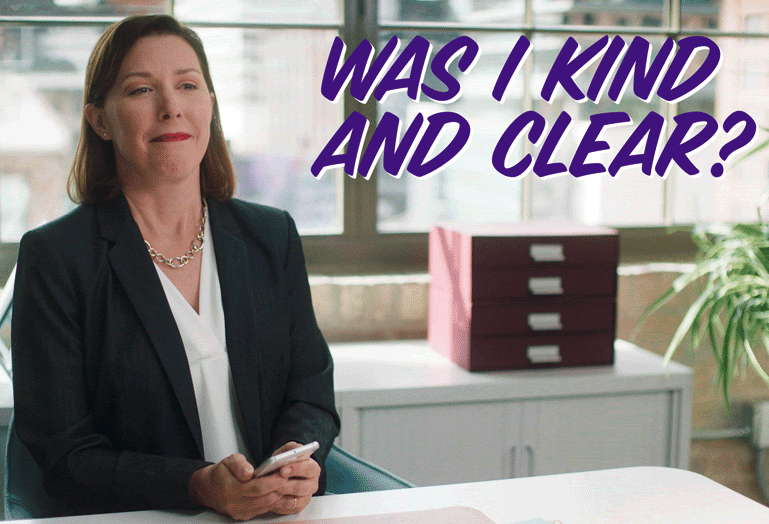13 Tips from Kim Scott & Kelly Leonard to Help You Work From Home Like a Boss
Working remotely is hard. If you work from home, it’s really important to have quick, frequent interactions with the people you collaborate with. This will allow you to pick up on people’s most subtle emotional cues. I learned this from my boss when I lived in Russia. He made a point of calling me every day from New York, if only for a three-minute check-in call. He had operations in Africa in the 1970s and had learned the importance of frequent communication to pick up on emotional cues from people in far-flung locations.
A video call, if you have high-speed internet access, is second best to in-person communication. If the connection is spotty, use phone for voice and video as a bonus, muting your computer. Phone is third best. Email and text should be avoided if at all possible.
It always feels faster to fire off an email or text, but when I think about all the times I had to spend hours clearing up a misunderstanding that arose from an email that was misinterpreted, I realize that it’s actually faster to pick up the phone and talk live.
Need more work from home hacks? My Improvising Radical Candor co-creator Kelly Leonard and I put together some tips to help everyone work better together while physically apart.
Work from Home Tips from Kim & Kelly
1. Listen to the end of everyone’s sentence before you respond. We have an improv exercise where you have to respond to someone by starting your response with the last word they said — try it — you’ll realize you don’t listen to the end of sentences.
2. Cede the need to be right — avoid group mind and, instead, utilize group intelligence.
3. Make sure there is a clear meeting agenda that everyone is aware of.
4. Designate one person to lead and run the meeting. These virtual meetings are a bit of a performance and they need a director.
5. Keeping in line with the performance aspect: good lighting — facing toward a window is good; no need for a suit and tie, but don’t wear a bathrobe; pick a good stage — a spot in your home that is as quiet as possible and you won’t be distracted or become a distraction to others.
6. Start each meeting with a check-in. When people know what’s going on for one another the sudden visibility into each other’s living rooms is less distracting; we can better interpret why someone might be sharp or short; and it’s natural to care more when you know more.
7. For 1:1 meetings virtually, have shorter meetings more frequently. A lot happens in a week. And it’s hard to set aside a full hour if one of you has kids with frequent needs. Shorter calls are easier to fit into chaotic days. And you might even try opportunistic calling rather than trying to fit to a schedule.
8. Be conscious of why you are using synchronous meetings. Any work that can get done asynchronously, do it that way so everyone can manage what’s going on in the background. But synchronous calls are really important for bonding. Asynchronous efficiency, synchronous bonding.
9. If you have a team in a very different time zone, try working on their time zone once in a while to give more space for synchronous communication.
10. Be conscious of how much time you are talking versus other people in meetings when you work from home. If you’re taking up more than your fair share of time try to be more quiet. If you are not speaking up, remember that it is an act of generosity to share what you are thinking. If you are leading the meeting, consider occasionally just going person by person in alphabetical order. Teams that speak roughly an equal amount of time perform better than teams where one person takes up all the airtime.

11. Sometimes replicating in-person activities remotely can work. If you both get a cup of tea, a video call can feel more human. Take an extra moment to talk about something beautiful you saw, or something funny you heard.
12. Focus on being a partner, not an absentee manager or a micromanager. This is always important, but it’s even more important to remember when your whole team is remote. Remember that everyone is different, which is why you need to ask each member of your team what works for them. While some people may want to hop on the phone several times a day to talk, others might find this disruptive and stressful. Don’t assume that what works for one person will work for every person.
13. Most importantly, remember to be kind…All this social distancing can leave people feeling lonely. A few extra minutes to connect with people who work from home is time well spent.
Kim Scott is the author of the New York Times and Wall Street Journal bestseller Radical Candor: Be a Kickass Boss without Losing your Humanity and the co-founder of Radical Candor, LLC.
Kelly Leonard is the executive director of insights and applied improvisation at Second City Works. He is also author of the book, Yes, And: Lessons from The Second City.
Improvising Radical Candor, a partnership between Radical Candor, LLC and Second City Works, produces live and virtual content, including the new workplace comedy series The Feedback Loop, to help people practice Radical Candor through improv.

